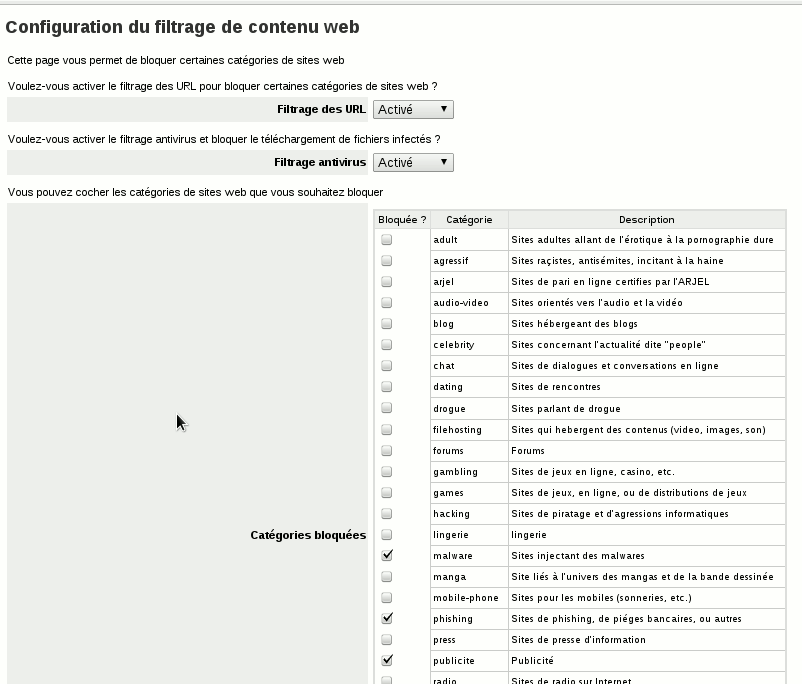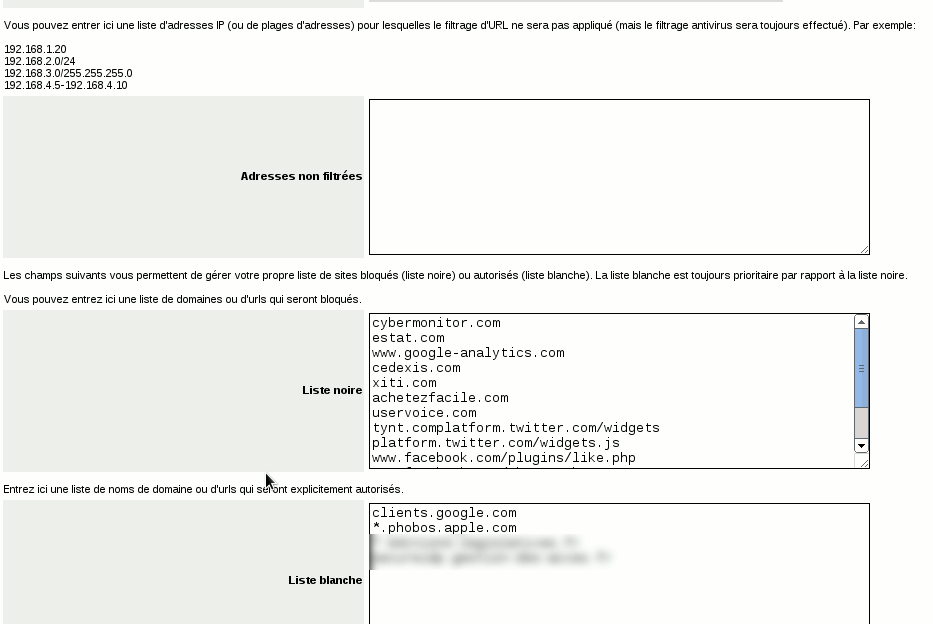WebFilter
Maintainer
Daniel B.
Firewall Services
mailto:daniel@firewall-services.com
Description
This contrib brings 3 new features for squid proxy, and provides a simple panel to control most of it:
- URL Filtering (with squidGuard)
Several categories of domain names and URLs are downloaded from the University of Toulouse and updated every night (you can get more informations on these lists here), in french). You can then just choose which categories you want to block. You can enter a list of ip addresses which won't be filtered, and a local blacklist and whitelist.
- On the fly anti-virus scanning (using squidclamav)
When enabled, all web traffic will be scanned before being sent to the client
- log every requests in a MySQL database
Every request passing through squid is logged in a database, making it easier to analyze squid logs. There's no front-end for this, but you can use your favourite mysql client to see which domains are the most visited, which user eats all your bandwidth, etc...
This contrib can replace dansguardian if you have simple filtering requirements. It's really easy to configure, but is also less powerful. Dansguardian is a real content scanner (it analyse the content of the pages while squidguard only look at the URLs for example).
Requirements
- SME Server 8 (not tested and not supported on SME 7)
- You need to configure both Epel and Fws repositories
Screenshots
Installation 8.x and 9.x
To install the contrib, simply run the following command:
yum --enablerepo=epel --enablerepo=fws install smeserver-webfilter signal-event http-proxy-update expand-template /etc/httpd/conf/httpd.conf sv t /service/httpd-e-smith
You can then access the new panel in the server-manager. The first time you access it, you might have an empty category list. Just click the save button at the bottom of the page, wait a few minutes and try again (the list is empty because categories hasn't been downloaded yet). Now, you should be able to enable URL and AV filtering, and choose which categories you want to block. The next settings modification might take a long time (several minutes, you may also have a timeout error displayed). This is expected and is because squidGuard databases need to be compiled. After this, settings change should be fast.
AV filtering and smartphones applications stores
When AV filtering is enabled, the AV engine overrides the client's UserAgent with its own, and this will break access to some websites, like the iOS AppStore and Android GooglePlay. To get arround this problem, just add the following in the whitelist:
clients.google.com android.clients.google.com *.phobos.apple.com
With this, those appstores won't be scanned by the AV engine, and they will work just as before.
Customize category lists
Category lists are simple text files in /var/squidGuard/blacklists. Each category is a directory, and each directory may have a file named domains and another named urls. Each directory in /var/lib/squidGuard/blacklists will be displayed in the panel of the server-manager, except if it's listed in the DisabledCategories prop. You can see which categories are disabled with:
db configuration getprop squidguard DisabledCategories
This lets you ignore some useless categories, and hide them from the panel. The default config update all the categories each night. This is done in the cron job /etc/cron.daily/squidGuard, which calls /etc/e-smith/events/actions/squidguard-update-databases. If you don't want to auto update those lists, you can disable this feature:
db configuration setprop squidguard AutoUpdate disabled
You can add your own categories. If they don't already exists, they won't be deleted or modified by the update feature.
Denied page
With the default configuration, denied requests are redirected to https://hostname.domain.tld/squidGuard/cgi-bin/blocked.cgi with various parameters (like IP address, username, client group, category etc...). Username will be empty (only -), this is because squid authentication is disabled. If you enable squid authentication (with custom templates), you'll be able to log username. The downside is that you'll have to configure all your browsers to use squid as proxy, because authentication is not compatible with transparent proxying.
If you want to change the blocked page, you can. First, copy the default page to another name:
cp -a /usr/share/squidGuard/cgi-bin/blocked.cgi /usr/share/squidGuard/cgi-bin/custom.cgi
Now, you can edit this new file to your need. Then, just select it as the default blocked page:
db configuration setprop squidguard RedirectURL \ http://hostname.systemname.com/squidGuard/cgi-bin/custom.cgi?clientaddr=%a&clientname=%n&clientuser=%i&clientgroup=%s&targetgroup=%t&url=%u signal-event http-proxy-update
MySQL logs
MySQL loging of clients requests is handled by a independent daemon called squid-db-logd. It monitors squid access log and squidGuard deny log in real time, parse it and put everything in the database called squid_log. In this database, the table access_log list all the access while the deny_log only list denied pages. This feature may need a lot of disk space. On a busy server, you can easily reach 3GB / month only for the database (and more for the dump when you backup your server). To limit the needed space, a cron job remove the oldest entries. The default config keeps one year of log. You can change this setting with (value is in day and default is 365)
db configuration setprop squid-db-logd Retention 180
If you want to completely disable this feature, you can stop this daemon:
db configuration setprop squid-db-logd status disabled sv d /service/squid-db-logd
Here are some example of queries you can run:
- Get the top 30 most visited domains
echo "SELECT DOMAIN,COUNT(DOMAIN) AS occurances FROM access_log GROUP BY DOMAIN ORDER BY occurances DESC LIMIT 30;" | mysql squid_log
- Get the top 10 most used blocked categories
echo "SELECT category,COUNT(category) AS occurances FROM deny_log GROUP BY category ORDER BY occurances DESC LIMIT 10;" | mysql squid_log
- get all the pages requested by the client 192.168.7.50 on Oct 12 2012 between 10pm and 11 pm, and export the result in /tmp/result.csv
echo "SELECT date_day,date_time,url,username INTO OUTFILE '/tmp/result.csv' FIELDS TERMINATED BY ',' OPTIONALLY ENCLOSED BY '"' ESCAPED BY '\\' LINES TERMINATED BY '\n' FROM access_log WHERE client_ip='192.168.7.50' AND date_day='2012-10-08' AND date_time>'22:00:00' AND date_time<'23:00:00';" mysql squid_log
Uninstall
If you want to uninstall this contrib, just run:
yum remove squidguard squidclamav expand-template /etc/squid/squid.conf squid -k reconfigure expand-template /etc/httpd/conf/httpd.conf sv t /service/httpd-e-smith
And if you want to remove every trace of it:
rm -rf /var/log/squid-db-logd rm -rf /var/log/squidGuard rm -f /home/e-smith/db/mysql/squid_log.dump echo "drop database squid_log;" | mysql rm -rf /var/squidGuard rm -f /etc/squid/squidGuard.conf rm -f /etc/squidclamav.conf
Sources
You can find the srpm in our repo here: http://repo.firewall-services.com/centos/5/SRPMS/ You can also browse sources and clone the contrib from our git repo here: https://gitweb.firewall-services.com/?p=smeserver-webfilter;a=summary
Panel and translation
The panel is translated in English, French, Dutch and Italian.
For now, this contrib is not available for translation in pootle (because it's in our own GIT repo). If you want to help with translation, you can get the file /etc/e-smith/locale/en-us/etc/e-smith/web/functions/webfilter (or directly from here) translate it, and send it back to us by mail at tech @ firewall-services . com

